empirical conclusion
1. Experimental task 1
Task 1-1
(1)task1_1.asm source code
assume ds:data, cs:code, ss:stack
data segment
db 16 dup(0)
data endsstack segment
db 16 dup(0)
stack ends
code segment
start:
mov ax, data
mov ds, axmov ax, stack
mov ss, ax
mov sp, 16mov ah, 4ch
int 21h
code ends
end start
(2)task1_1 screenshot before the end of line17 and line19

(3) Question answer ① in debug, execute until the end of line17 and before line19, and record this time: register (DS) =_ 076A___, Register (SS) =__ 076B__, Register (CS) =_ 076C___
② Assuming that the segment address of the code segment is X after the program is loaded, the segment address of the data segment is X_ X-2___, The segment address of stack is_ X-1___.
(debug shows that CS=076C in this question)
Task 1-2
(1) task1_2.asm source code
assume ds:data, cs:code, ss:stack data segment db 4 dup(0) data ends stack segment db 8 dup(0) stack ends code segment start: mov ax, data mov ds, ax mov ax, stack mov ss, ax mov sp, 8 mov ah, 4ch int 21h code ends end start
(2) task1_2 screenshot of observing the values of registers DS, CS and SS before debugging to the end of line17 and line19

(3) Question answer ① in debug, execute until the end of line17 and before line19. Record this time: register (DS) = 076a_, register (SS) = 076b_, register (CS) = 076c_
② Assuming that the segment address of the code segment is X after the program is loaded, the segment address of the data segment is _X-2 and the segment address of the stack is _X-1.
Task 1-3
(1) Task task1_3.asm source code
assume ds:data, cs:code, ss:stack
data segment
db 20 dup(0)
data ends
stack segment
db 20 dup(0)
stack ends
code segment
start:
mov ax, data
mov ds, ax
mov ax, stack
mov ss, ax
mov sp, 20
mov ah, 4ch
int 21h
code ends
end start
(2) task1_3 screenshot of observing the values of registers DS, CS and SS before debugging to the end of line17 and line19

(3) Question answer ① in debug, execute until the end of line17 and before line19. Record this time: register (DS) = 076a_, register (SS) = 076c_, register (CS) = 076e_
② Assuming that the segment address of the code segment is X after the program is loaded, the segment address of the data segment is _X-4 and the segment address of the stack is _X-2.
Tasks 1-4
(1) Task task1_4.asm source code
1 assume ds:data, cs:code, ss:stack 2 code segment 3 start: 4 mov ax, data 5 mov ds, ax 6 7 mov ax, stack 8 mov ss, ax 9 mov sp, 20 10 11 mov ah, 4ch 12 int 21h 13 code ends 14 15 data segment 16 db 20 dup(0) 17 data ends 18 19 stack segment 20 db 20 dup(0) 21 stack ends 22 end start
(2) task1_4 before the end of line9 and line11 debugging, observe the screenshot of the values of registers DS, CS and SS

(3) Answer to question ① in debug, it will be executed until the end of line9 and before line11. Record this time: register (DS) = 076c_, register (SS) = 076e_, register (CS) = 076a_
② Assuming that the segment address of the code segment is X after the program is loaded, the segment address of the data segment is _X+2 and the segment address of the stack is _X+4.
Tasks 1-5
Based on the practice and observation of the above four experimental tasks, summarize and answer:
① For the segment defined below, after the program is loaded, the actual memory space allocated to the segment is _ N bytes.
xxx segment
db N dup(0)
xxx ends
② If the pseudo instruction end start in the programs task1_1.asm, task1_2.asm, task1_3.asm and task1_4.asm is changed to end, which program can still be executed correctly. Combined with the conclusions obtained from practical observation, analyze and explain the reasons.
A: after practice, only task1_4.asm can run correctly after the pseudo instruction end start is changed to end. Because end can not only inform the compiler of the end of the program, but also inform the compiler of the entry of the program. In the four programs in this question, the entry is at the label start; after removing start, the first three programs cannot find the entry, and only the code segment of the fourth program is at the beginning, which can be used To find the entrance.
2. Experimental task 2
(1) Assembly code
1 assume cs: code 2 3 code segment 4 start: 5 mov ax, 0b800h 6 mov ds, ax 7 8 mov bx, 0f00h 9 mov cx, 50h 10 mov ax, 0403h 11 s : 12 mov [bx], ax 13 add bx, 2 14 loop s 15 16 mov ah, 4ch 17 int 21h 18 code ends 19 end start
(2) Screenshot of operation results
(file name is 1.ASM)
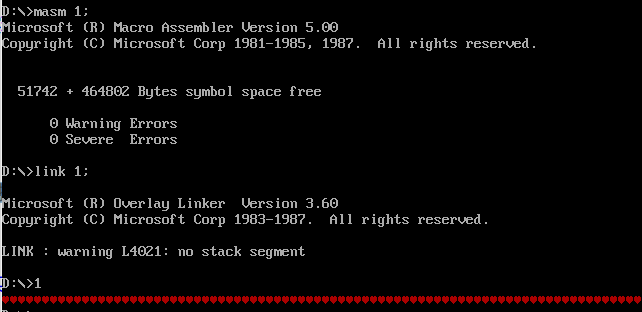
The result is the same as that of task 3 of Experiment 1
3. Experimental task 3
(1) Assembly code
1 assume cs:code ,ds:data1 2 data1 segment 3 db 50, 48, 50, 50, 0, 48, 49, 0, 48, 49 ; ten numbers 4 data1 ends 5 6 data2 segment 7 db 0, 0, 0, 0, 47, 0, 0, 47, 0, 0 ; ten numbers 8 data2 ends 9 10 data3 segment 11 db 16 dup(0) 12 data3 ends 13 14 code segment 15 start: 16 mov ax, data1 17 mov ds, ax 18 mov bx, 0 19 mov cx, 0ah ;Cycle 10 times 20 s: 21 mov ax, [bx] 22 add ax, [bx+10h] 23 mov [bx+20h], ax 24 inc bx 25 loop s 26 27 mov ah, 4ch 28 int 21h 29 code ends 30 end start
(2) Screenshot
-u view loading, - g view running results
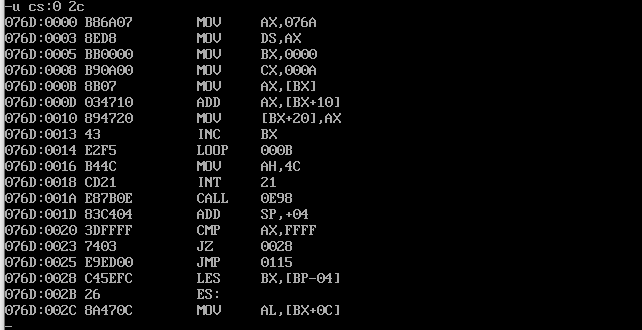
Segment before addition:
It can be seen that although there are only 10 data, the program still allocates 16 byte space for data1 and data2, and the data of data3 is all 0

Data segment after addition:
You can see that data1 and data2 are added to data3

4. Experimental task 4
(1) Code
1 assume cs:code 2 3 data1 segment 4 dw 2, 0, 4, 9, 2, 0, 1, 9 5 data1 ends 6 7 data2 segment 8 dw 8 dup(0) 9 data2 ends 10 11 code segment 12 start: 13 mov ax, data1 14 mov ds, ax 15 mov bx, 000eh 16 mov cx, 8h 17 mov si, 2h 18 s: 19 mov ax, [bx] 20 mov [bx+si], ax 21 add si, 4 22 sub bx, 2 23 loop s 24 25 mov ah, 4ch 26 int 21h 27 code ends 28 end start
(2) Screenshot
-u view loading, - g view running results
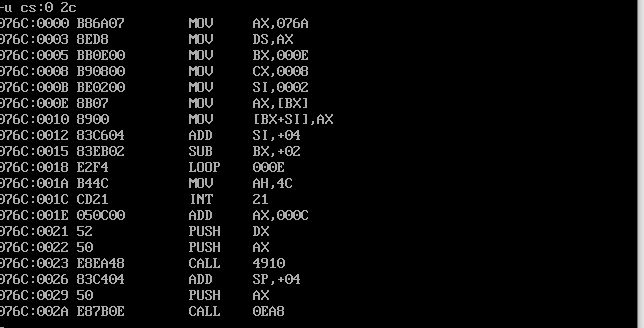
Initial memory:

Memory space corresponding to data2 stored in reverse order:
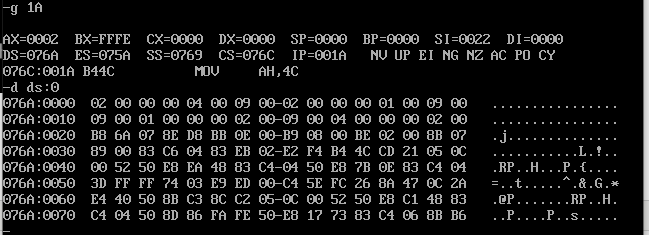
You can see that the reverse order of data1 is stored in data2, indicating that the program is successful
5. Experimental task 5
Source code:
1 assume cs:code, ds:data 2 data segment 3 db 'Nuist' 4 db 2, 3, 4, 5, 6 5 data ends 6 7 code segment 8 start: 9 mov ax, data 10 mov ds, ax 11 12 mov ax, 0b800H 13 mov es, ax 14 15 mov cx, 5 16 mov si, 0 17 mov di, 0f00h 18 s: mov al, [si] 19 and al, 0dfh 20 mov es:[di], al 21 mov al, [5+si] 22 mov es:[di+1], al 23 inc si 24 add di, 2 25 loop s 26 27 mov ah, 4ch 28 int 21h 29 code ends 30 end start
(1) line15-25, the functions of the loop are:
Convert each letter of Nuist to uppercase and assign the corresponding color
(2) Screenshot of operation results:
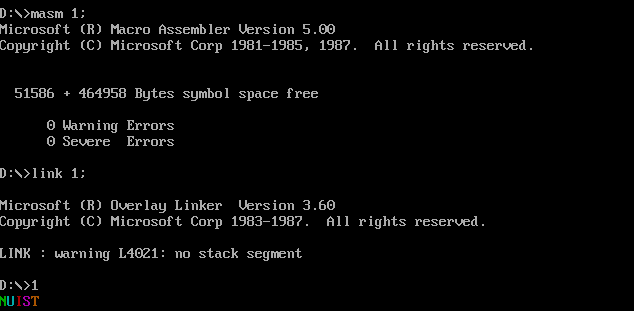
(3) Use the debug tool to debug the program, and use the g command to execute it once before the program returns (i.e. after ine25 and before line27):

(4) Function of line19 in source code:
Lowercase to uppercase
(5) What is the purpose of the byte data in the data segment line4 in the source code?
Change the value of 5 byte units in line4 to db 5 dup(2) operation result:
Change the value of 5 byte units in line4 to db 5 dup(5) operation result:
Function: set the color of NUIST
6. Experimental task 6
(1) Completion code:
1 assume cs:code, ds:data 2 3 data segment 4 db 'Pink Floyd ' 5 db 'JOAN Baez ' 6 db 'NEIL Young ' 7 db 'Joan Lennon ' 8 data ends 9 10 code segment 11 start: 12 mov ax, data 13 mov ds, ax 14 mov bx, 0 15 mov cx, 4 ;Four strings 16 s0: 17 mov dx, cx 18 mov si, 0 19 mov cx, 4 ;Four letters 20 s: 21 mov al, [bx+si] 22 or al, 20h 23 mov [bx+si], al 24 inc si 25 loop s 26 27 mov cx, dx 28 add bx, 16 29 loop s0 30 31 mov ah, 4ch 32 int 21h 33 code ends 34 end start
(2) Screenshot of loading, disassembling and debugging in debug:
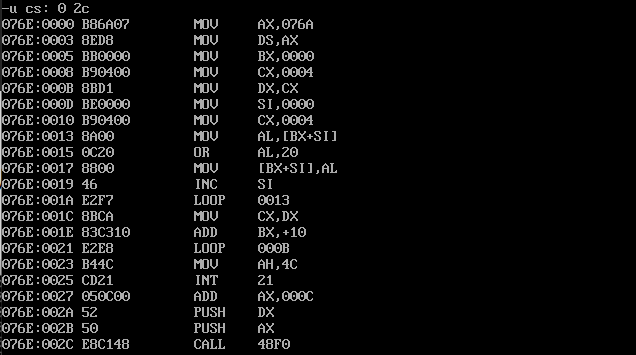

(3) Use the d command to view a screenshot of the memory space corresponding to the data segment data:
Step by step debugging to load the data address into ds:

Run debug until the program exits, and use the d command to view a screenshot of the memory space corresponding to the table segment:
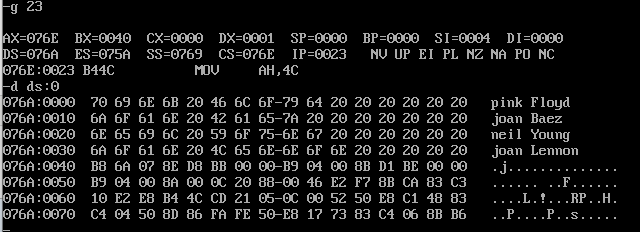
You can see that the first word in each line of the data segment data has been changed from uppercase to lowercase.
7. Experimental task 7
(1) Write code:
1 assume cs:code, ds:data, es:table 2 3 data segment 4 db '1975', '1976', '1977', '1978', '1979' 5 dw 16, 22, 382, 1356, 2390 6 dw 3, 7, 9, 13, 28 7 data ends 8 9 table segment 10 db 5 dup( 16 dup(' ') ) ; 11 table ends 12 13 code segment 14 start: 15 16 mov bp, 0 ;table Starting address of each line 17 mov si, 0 ;every time+2 18 mov di, 0 ;every time+4,Year start 19 mov cx, 5 20 mov ax, data 21 mov ds, ax 22 mov ax, table 23 mov es, ax 24 25 s: 26 mov ax, ds:[bp] ;particular year 27 mov es:[di], ax 28 mov ax, ds:[bp+2] 29 mov es:[di+2], ax 30 mov ax, [si+014h] ;income si+014h 31 mov es:[di+5], ax 32 mov dx,[si+014h+2] 33 mov es:[di+7],dx 34 mov dx , [si+01eh] ;employee si +01eh 35 mov es:[di+0ah], dx 36 37 mov dx, 0 ;per capita income 38 div word ptr [si+01eh] ;dx*16+ax /si+01eh 39 mov es:[bx+0dh], ax 40 41 ;Separate into spaces 42 mov byte ptr es:[bx+4],020h 43 mov byte ptr es:[bx+9],020h 44 mov byte ptr es:[bx+0ch],020h 45 mov byte ptr es:[bx+0fh],020h 46 47 add di, 010h 48 add bp, 4 49 add si, 2 50 loop s 51 52 mov ah, 4ch 53 int 21h 54 code ends 55 end start
(2) Debug screenshot: view the screenshot of the original data information of the table segment. Run in debug until the program exits, use the d command to view the screenshot of the memory space corresponding to the table segment, and confirm whether the information is structurally written to the specified memory as required
The es segment address can be seen in debug: 076d

Original data information of table segment:

In debug, before the program exits, use the d command to view the memory space corresponding to the table segment:
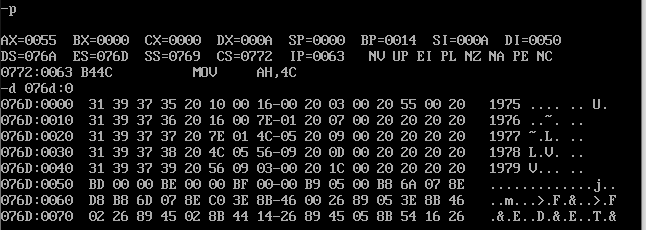
empirical conclusion
(1) If the hexadecimal number is preceded by a letter, be sure to add 0; (error prone in writing!);
(2) In experiment task 6, at the beginning, there was no mov dx and cx in s0 (dx was used to temporarily store cx), and mov cx and dx in s (returned the cx of the external circulation) fell into a dead cycle;
(3) When writing, I found that I was not good at using stack segment related operations, which needs to be strengthened.